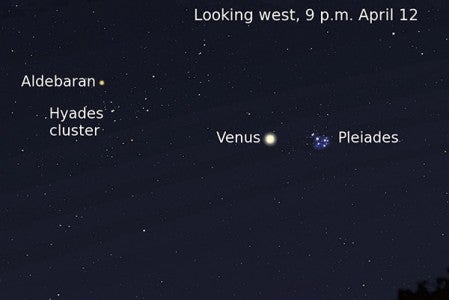April ramps up
Published 5:23 pm Saturday, March 28, 2015
 Minnesota StarWatch
Minnesota StarWatch
By Deane Morrison
April wastes little time bringing us its biggest event: a full moon undergoing a total eclipse the morning of the 4th.
The eclipse begins at 5:16 a.m., with totality starting at 6:58 a.m. However, in eastern Minnesota the moon sets shortly before totality begins, in the most western areas of the state the moon sets right after it ends, and totality itself lasts only five minutes. But there’s also good news: Since all this happens around sunrise, we’ll be treated to the unusual sight of a darkened moon setting against a bright sky.
This eclipse is the third in a tetrad, which comprises four lunar eclipses in a row that are all total. It happens to April’s full pink moon, named for the grass pink, or wild ground phlox, a widespread spring flower. September’s harvest moon eclipse completes the tetrad.
The evening sky features the adventures of Venus, which is now climbing past the winter stars as they sink into the sunset. Between the 10th and 12th, our brilliant sister planet skirts the Pleiades star cluster. During the next few days, Venus also passes the V-shaped Hyades cluster and orange Aldebaran, the eye of Taurus, the bull. On the 21st a waxing crescent moon joins the assembly.
High in the south after nightfall, Jupiter is moving with the rearguard of winter stars on its way to a rendezvous with Venus at the end of June. The king of planets now resides between Leo, the lion, and the subdued beauty of the Beehive star cluster. The bright star east of Jupiter is Regulus, the heart of the lion; it anchors the Sickle of stars outlining Leo’s head. A triangle of stars further east marks the hindquarters and tail.
April is the best month to see Leo, a prancing figure high in the south an hour or two after sunset. To find the Beehive, grab your binoculars and look west of Jupiter.
Early risers can see Saturn in the dark predawn sky. Low in the south, it masquerades as one of the claws of S-shaped Scorpius. Just southeast of Saturn, the gigantic red star Antares marks the scorpion’s heart.
The Lyrid meteor shower peaks the night of the 22nd-23rd. Meteors radiate from the east near Vega, the brilliant star in the constellation Lyra, the lyre. About 10 to 20 meteors per hour are predicted, but the Lyrids occasionally erupt in bursts of close to 100 per hour.
April ends with the Celtic holiday Beltane, now celebrated as May Day. For the evil spirits that had plagued humankind since Halloween (the Celtic holiday Samhain), the night of April 30 was their last fling before a six-month exile. Like Samhain, Beltane is a “cross-quarter day,” falling midway between an equinox and a solstice. The Celts regarded Beltane as the start of the light half of the year.
The University of Minnesota offers public viewings of the night sky at its Duluth and Twin Cities campuses.

